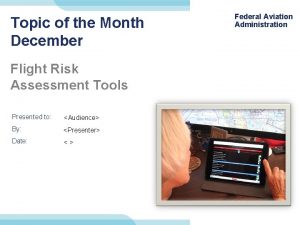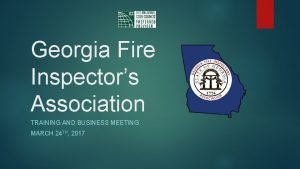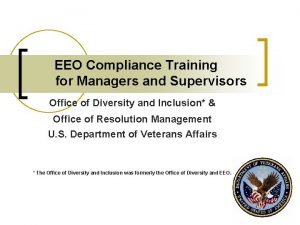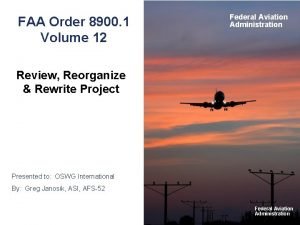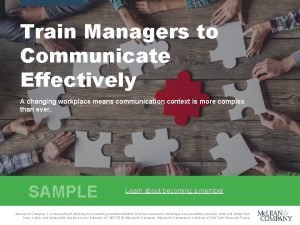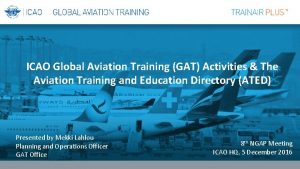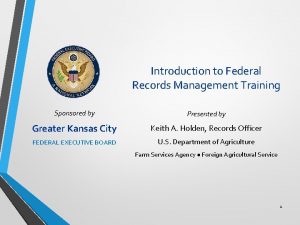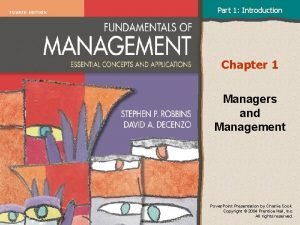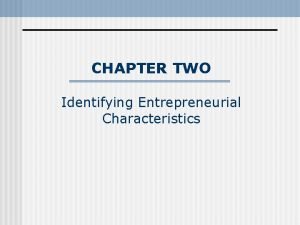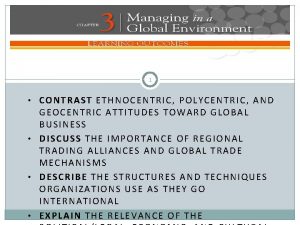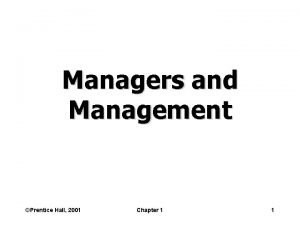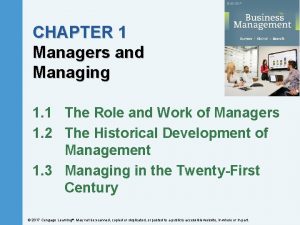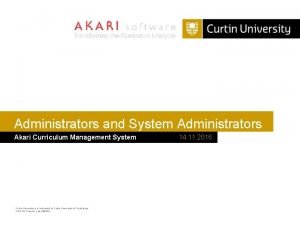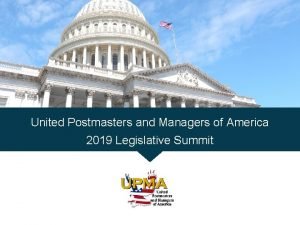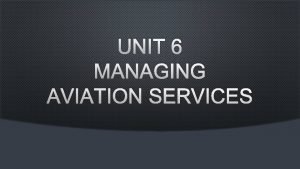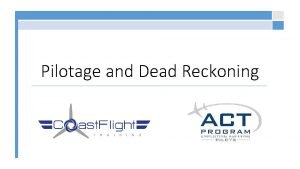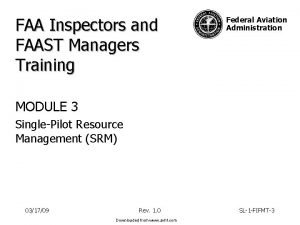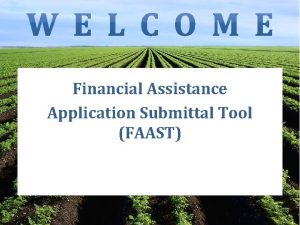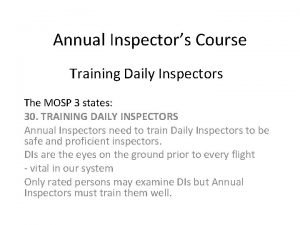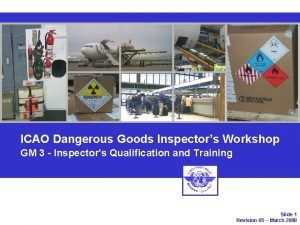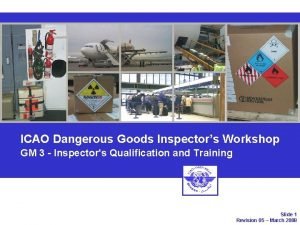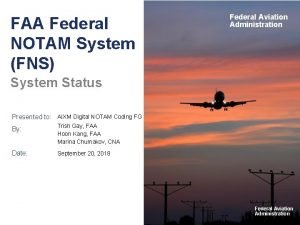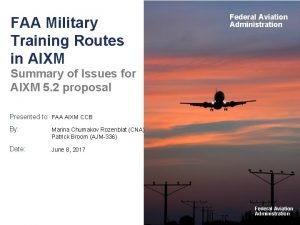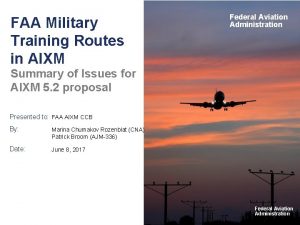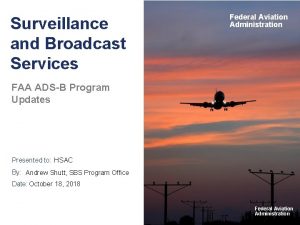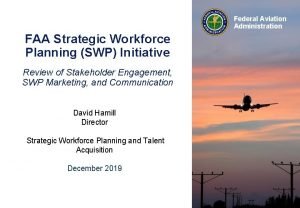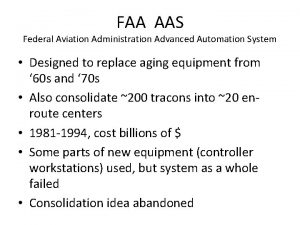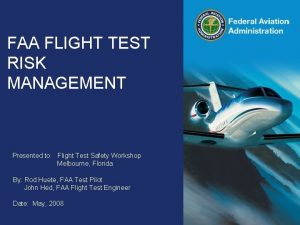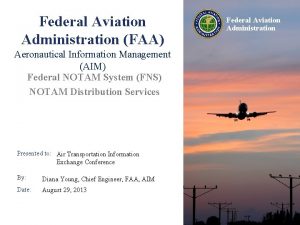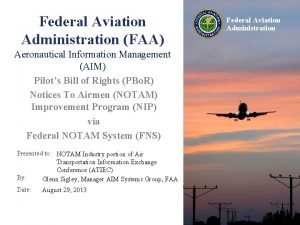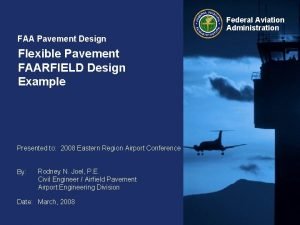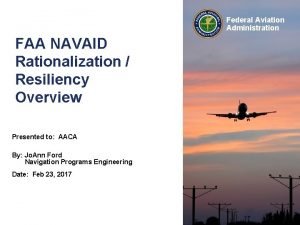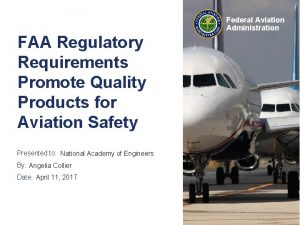FAA Inspectors and FAAST Managers Training Federal Aviation

























- Slides: 25

FAA Inspectors and FAAST Managers Training Federal Aviation Administration MODULE 1 Introduction 03/10/09 Downloaded from www. avhf. com Rev. 1. 0 SL-1 -FIFMT-1

Objectives • Upon completing this lesson: – You will understand the background, goals, philosophy, imperatives, and implementation of SBT, SRM, and LCG. – You will understand the importance of using SBT, SRM, and LCG in flight training. Federal Aviation Administration SL-2 -FIFMT-1 Downloaded from www. avhf. com

Overview • This is the first module of the FAA Inspectors and FAAS Managers Training Seminar. • Why use SBT, SRM, and LCG and where did they come from? • What are the goals, philosophy, and imperatives and how can they be implemented? Federal Aviation Administration SL-3 -FIFMT-1 Downloaded from www. avhf. com

Why do this? • To facilitate learning in order to reduce or prevent pilot-error accidents. Federal Aviation Administration SL-4 -FIFMT-1 Downloaded from www. avhf. com

Background • Seventy-five to 80% of GA accidents are caused by human factors (pilot errors) • Judgment and decision-making can be taught and evaluated using STB, SRM, and LCG. • The FITS studies showed significant improvement. Federal Aviation Administration SL-5 -FIFMT-1 Downloaded from www. avhf. com

Background (cont. ) • The development process: – Determined best practices currently in use. – Identified best practices for improving learning and enhancing judgment. – Tested the effectiveness. – Developed generic training syllabi. – Recommended changes to PTS and developed grading rubrics. Federal Aviation Administration SL-6 -FIFMT-1 Downloaded from www. avhf. com

Scenario-Based Training (SBT) • SBT is a training system (teaching method) that uses a highly structured script of real-world experiences to address flight-evaluation in an operational environment. Federal Aviation Administration SL-7 -FIFMT-1 Downloaded from www. avhf. com

Single-Pilot Resource Management (SRM) • SRM is the art and science of managing all resources (both on-board the aircraft and from outside sources) available to a single pilot (prior and during flight) to ensure the successful outcome of the flight is never in doubt. • SRM includes ADM, RM, AM, TM, SA, and CFIT avoidance. Federal Aviation Administration SL-8 -FIFMT-1 Downloaded from www. avhf. com

Learner-Centered Grading (LCG) • LCG is a grading system and a debriefing technique that provides: – clear feedback about progress toward achieving desired outcomes, – progress to other instructors and flight managers, and – opportunities to enhance learning as well as practice and rehearse judgment and decision-making. Federal Aviation Administration SL-9 -FIFMT-1 Downloaded from www. avhf. com

Goals • The goals are to: – improve the acquisition of aeronautical knowledge and – enhance the development of judgment and aeronautical decision-making skills. Federal Aviation Administration SL-10 -FIFMT-1 Downloaded from www. avhf. com

Philosophy • The philosophy is to use maneuvers in scenarios to improve learning and recall, and to emphasize the development of judgment and decision-making skills. Federal Aviation Administration SL-11 -FIFMT-1 Downloaded from www. avhf. com

Why scenarios? • Scenarios engage and motivate. – To facilitate learning • The pilot must actively engage in the learning process. • Learning activities must be realistic and authentic – Authentic to the pilot • The pilot needs to understand how the new knowledge relates to his or her previous experience or knowledge Federal Aviation Administration SL-12 -FIFMT-1 Downloaded from www. avhf. com

Aeronautical Decision-Making • Is defined as a systematic approach to the mental process and mental skills used by pilots to consistently determine the best course of action in response to a given set of circumstances. • The mental skills are analysis, synthesis, and evaluation. • Can be taught like any other mental skill. • Needs to be practiced and rehearsed. Federal Aviation Administration SL-13 -FIFMT-1 Downloaded from www. avhf. com

Practice Exercise Federal Aviation Administration SL-14 -FIFMT-1 Downloaded from www. avhf. com

With a partner: • Pick a common GA single-engine emergency and set up the circumstances surrounding the emergency. • Develop an appropriate response. Federal Aviation Administration SL-15 -FIFMT-1 Downloaded from www. avhf. com

Can We Do Better? • We picked an emergency • Developed a response • To practice and rehears judgment (analysis, synthesis, and evaluation), we need more steps in the learning process Federal Aviation Administration SL-16 -FIFMT-1 Downloaded from www. avhf. com

Teaching & Learning Method • Give the pilot a problem or task to solve • Have the pilot reflect on how he/she solved the problem and determine if there were other ways the problem could have been solved • Have the pilot re-solve the problem using additional information or another way Federal Aviation Administration SL-17 -FIFMT-1 Downloaded from www. avhf. com

Teaching & Learning Method (cont. ) • Have the pilot choose which solution is best • Challenge the pilot to describe “best” and consider if the “best solution” is always the same solution Federal Aviation Administration SL-18 -FIFMT-1 Downloaded from www. avhf. com

Back to the Practice Exercise Federal Aviation Administration SL-19 -FIFMT-1 Downloaded from www. avhf. com

Revisit Your Solution • • Reflect Re-solve Select which is best What is “best” Federal Aviation Administration SL-20 -FIFMT-1 Downloaded from www. avhf. com

Imperatives • Pilot training must include teaching methods that develop judgment and decision-making skills as well as engagement in the learning process and includes realistic and authentic learning activities • These teaching methods are SBT, LCG, and SRM Federal Aviation Administration SL-21 -FIFMT-1 Downloaded from www. avhf. com

Implementation • Incorporate SBT, LCG, and SRM • Use a problem or task as the learning activity center-piece • Use a scenario and the judgment assessment rubric to evaluate judgment and decision-making Federal Aviation Administration SL-22 -FIFMT-1 Downloaded from www. avhf. com

Review • Seventy-five to 80% of the GA accidents are caused by pilot error • Pilots can be taught judgment and decisionmaking skills • Pilots need to practice and rehearse analysis, synthesis, and evaluation skills • SBT, SRM, and LCG are effective tools for teaching, providing practice, and rehearsal opportunities Federal Aviation Administration SL-23 -FIFMT-1 Downloaded from www. avhf. com

Objectives • Upon completing this lesson: – You will understand the background, goals, philosophy, imperatives, and implementation of SBT, SRM, and LCG. – You will understand the importance of using SBT, SRM, and LCG in flight training. Federal Aviation Administration SL-24 -FIFMT-1 Downloaded from www. avhf. com

FAA Inspectors and FAAST Managers Training Federal Aviation Administration MODULE 1 Introduction The End 03/10/09 Downloaded from www. avhf. com Rev. 1. 0 SL-25 -FIFMT-1
 Faa faast
Faa faast Faast frat
Faast frat Rsoo
Rsoo Gafsed
Gafsed Food inspectors seize a minimum of ___ samples a month
Food inspectors seize a minimum of ___ samples a month The inspectors season 1 episode 1
The inspectors season 1 episode 1 Worcester inspectional services
Worcester inspectional services Eeo compliance training
Eeo compliance training Eeo compliance training
Eeo compliance training Faa training order
Faa training order Effective communication
Effective communication Icao global aviation training
Icao global aviation training Federal records management training
Federal records management training Difference between an entrepreneur and a manager
Difference between an entrepreneur and a manager Differentiate between entrepreneur and intrapreneur
Differentiate between entrepreneur and intrapreneur Chapter 1 managers and managing
Chapter 1 managers and managing Jeff bezos accident
Jeff bezos accident Difference between entrepreneurs and managers
Difference between entrepreneurs and managers Conventional entrepreneur
Conventional entrepreneur Polycentric attitude towards global business
Polycentric attitude towards global business Managers and management chapter 1
Managers and management chapter 1 Managers and management chapter 1
Managers and management chapter 1 Akari curriculum
Akari curriculum Upma usps
Upma usps Unit 6 aviation geography and terminology
Unit 6 aviation geography and terminology Dead reckoning and pilotage
Dead reckoning and pilotage

